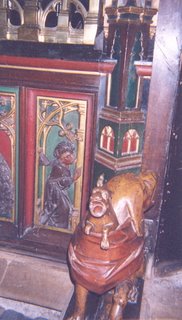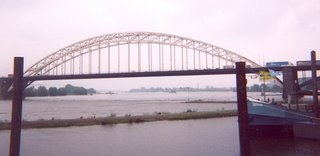 Corrie ten Boom House, Interior, hiding place, Haarlem, the Netherlands
Corrie ten Boom House, Interior, hiding place, Haarlem, the Netherlands
The Corrie ten Boom house, on the left, is another home where people hid during WWII, this time in the walls, but for a vastly shorter period of time than The Anne Frank family in Amsterdam (a week, if even that?). Details about CTB's life and the house are at www.corrietenboom.com/.
Some 800 Jews were saved in this way, see New York Times article by Beth Greenfield,
Classic Dutch City With A Village Feel, at ://travel.nytimes.com/2009/07/19/travel/19dayout.html?partner=rss&emc=rss/
There is the space within the walls for hiding.
Finally, when word got out, the Nazis were in and out, searching for them, and during that week, the stakes for the ten Boom family were just as immediate and dire as for the Franks, hidden in Amsterdam.
Corrie and the others did escape, over the roofs. Here is a conflict of information: We were told that the family escaped, but the NYT article says they were caught, sent to concentration camps, and Corrie survived. We are checking now. Perhaps the museum information was only for a particular search week.
Plan much time for this stop, if you have it - the tour (you cannot go through on your own) is lengthy. There are compulsory sectarian promotions for up to an hour before you can get in the rest of the house. You cannot go through on your own, to speed things up if you are not interested in the motivational speakers.
Also, to accommodate the lectures, the doors only open at certain times.
Be there on the spot. Doors close. The article expressed surprise that people were already milling about the door at 2PM. That is because people are only allowed in on the dot of the hour, and nobody during lunch.
I did read some of Corrie Ten Boom's writings, and they are pensive, human and insightful. The house presentation, however, tends to defeat that. Too forced and evangelical, for me. They want to proseletyze.
The Bavo Church, the Grote Kerke; St. Bavo Kerke - Kerke=Church.
The Grote Kerk. It is named after Saint Bavo, who turns out to have been an abuser -- of his wife and family and servants in the 6th Century. He converted, but that means, at that time, that he gave up the worldly life and entered a monastery, not that he became
Christian. Doctrines were in flux. Apparently he heard a particularly moving sermon by missionary and cleric St. Amand, see Amand at ://www.catholic.org/saints/saint.php?saint_id=333.
Bavo ended up a hermit in a forest near Ghent, Belgium. See ://www.aug.edu/augusta/iconography/bavo.html/ Saint Bavo the Abuser.
In the church is a large Foucault Pendulum setup, after the experiment in 1851 by Foucault to show the earth's rotation. It does, has, is ongoing, for your peace of mind on that issue. See ://www.travelpod.com/travel-blog-entries/yearoftheshorts/1/1268469287/tpod.html/. And three ship-model chandeliers, and a painted carving of a little fellow gnawing on a pew.
See him to the left, head tilted for a better bite. And there is a fierce snarling thing beside. Love religion. Woodworkers' revenge. The choir was built in about 1400, see ://www.nationalgallery.org.uk/paintings/gerrit-berckheyde-the-interior-of-the-grote-kerk-haarlem/.
.
 St. Bavo, Grote Kerke, Haarlem, the Netherlands, figure gnawing on pew, interior carving
St. Bavo, Grote Kerke, Haarlem, the Netherlands, figure gnawing on pew, interior carving
.
Vestries always have difficulties?
There also is another carving of a little fellow beneath the seats in the choir reserved for the wealthy - everyone else had to stand in the lower area. Is he really showing his disdain for the bottoms of his betters seated above him, by showing his below? Where is that picture? Am sure I got it.
Frans Hals is buried at the Grote Kerk. For the interior, see ://www.nationalgallery.org.uk/cgi-bin/WebObjects.dll/CollectionPublisher.woa/wa/largeImage?workNumber=NG1451&collectionPublisherSection=work/.
Haarlem's service for you ladies' District is low-key, clean, neat and tidy, and professional. It is near the main square, where the Grote Kerke is located. If you stroll by in the morning, the windows may well be empty and you can look at the chairs and props better. Tableaux. See before you buy.
The Frans Hals Museum is also there, but a longer walk away. Take time for the stroll. Haarlem was Frans Hals' home, at least for a substantial time. For his paintings, see ://www.abcgallery.com/H/hals/hals.html, Olga's Gallery.
 Keukenhof Gardens, tulips, Lisse, the Netherlands
Keukenhof Gardens, tulips, Lisse, the Netherlands Keukenhof. Tulip fields, Lisse, the Netherlands
Keukenhof. Tulip fields, Lisse, the Netherlands Dan Widing at Keukenhof Gardens, Lisse, The Netherlands. Hip-high tulips. Not a raised bed.
Dan Widing at Keukenhof Gardens, Lisse, The Netherlands. Hip-high tulips. Not a raised bed. Nijmegen, Bridge, Operation Market Garden, the Netherlands
Nijmegen, Bridge, Operation Market Garden, the Netherlands Bridge at Nijmegen, view with The Hotel Courage right there
Bridge at Nijmegen, view with The Hotel Courage right there Operation Market Garden tribute sculpture, Nijmegen, the Netherlands
Operation Market Garden tribute sculpture, Nijmegen, the Netherlands VE Day, 60th Anniversary Parade, Nijmegen, the Netherlands
VE Day, 60th Anniversary Parade, Nijmegen, the Netherlands Canadian War Cemetery, Military Piper and Dan Widing, Grosbeek, the Netherlands
Canadian War Cemetery, Military Piper and Dan Widing, Grosbeek, the Netherlands Canadian Guardsman, Grosbeek Canadian Military Cemetery, NL
Canadian Guardsman, Grosbeek Canadian Military Cemetery, NL Kinderdijk, windmill, the Netherlands
Kinderdijk, windmill, the Netherlands Working windmill with sails, near Kinderdijk NL
Working windmill with sails, near Kinderdijk NL Windmill row, Kinderdijk, the Netherlands
Windmill row, Kinderdijk, the Netherlands Polder, or drained farm land. See mast of boat at eye level, canal across the field, near Kinderdijk NL
Polder, or drained farm land. See mast of boat at eye level, canal across the field, near Kinderdijk NL Madurodam Miniature Village, Scheveningen, near the Hague, NL
Madurodam Miniature Village, Scheveningen, near the Hague, NL Scale of miniature village, Madurodam, NL
Scale of miniature village, Madurodam, NL Domburg, Allied Commando memorial, beach landing site, the Netherlands, WWII
Domburg, Allied Commando memorial, beach landing site, the Netherlands, WWII  Alkmaar Cheese Market Lady, Alkmaar NL
Alkmaar Cheese Market Lady, Alkmaar NL Alkmaar, cheese market, the Netherlands
Alkmaar, cheese market, the Netherlands Porters, Alkmaar cheese market, the Netherlands
Porters, Alkmaar cheese market, the Netherlands Color-coded cheese sleds, Alkmaar cheese market, NL
Color-coded cheese sleds, Alkmaar cheese market, NL World's best accommodation, Alkmaar, the Netherlands
World's best accommodation, Alkmaar, the Netherlands Weigh station for cheese wheels, on the sleds, Alkmaar Cheese Market, NL
Weigh station for cheese wheels, on the sleds, Alkmaar Cheese Market, NL Afluitsdijk, Commemorative sculpture to 1930's construction, causeway separating Zuiderzee from Ijsselmeer
Afluitsdijk, Commemorative sculpture to 1930's construction, causeway separating Zuiderzee from Ijsselmeer  Urk Island Lighthouse, now inland (land reclamation), the Netherlands
Urk Island Lighthouse, now inland (land reclamation), the Netherlands Urk, the Netherlands. Waterfront. Once a fishermen's community on an island, land reclaimed and getting yuppie.
Urk, the Netherlands. Waterfront. Once a fishermen's community on an island, land reclaimed and getting yuppie. Amersfoort, city walls, the Netherlands
Amersfoort, city walls, the Netherlands Hurdy-gurdy, Amersfoort, the Netherlands
Hurdy-gurdy, Amersfoort, the Netherlands Corrie ten Boom House, Interior, hiding place, Haarlem, the Netherlands
Corrie ten Boom House, Interior, hiding place, Haarlem, the Netherlands St. Bavo, Grote Kerke, Haarlem, the Netherlands, figure gnawing on pew, interior carving
St. Bavo, Grote Kerke, Haarlem, the Netherlands, figure gnawing on pew, interior carving